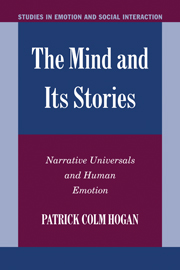Book contents
- Frontmatter
- Contents
- Acknowledgments
- The Mind and Its Stories
- Introduction: Studying Narrative, Studying Emotion
- 1 Literary Universals
- 2 Emotion and Suggestion: Lexical Processes in Literary Experience
- 3 Four Hypotheses on Emotion and Narrative
- 4 Writing Beyond the Ending: A Problem of Narrative, Empathy, and Ethics
- 5 Extending the Theory: Emotion Prototypes, Narrative Junctures, and Lyric Poetry
- 6 Testing, Revision, and the Program of Research in Narrative Universals: Ainu Epic and the Plot of Sacrifice
- 7 The Structure of Stories: Some General Principles of Plot
- Afterword: From the Emotional Nature of Narrative to the Narrative Nature of Emotion
- Works Cited
- Index
- Titles in the series
3 - Four Hypotheses on Emotion and Narrative
Published online by Cambridge University Press: 11 July 2009
- Frontmatter
- Contents
- Acknowledgments
- The Mind and Its Stories
- Introduction: Studying Narrative, Studying Emotion
- 1 Literary Universals
- 2 Emotion and Suggestion: Lexical Processes in Literary Experience
- 3 Four Hypotheses on Emotion and Narrative
- 4 Writing Beyond the Ending: A Problem of Narrative, Empathy, and Ethics
- 5 Extending the Theory: Emotion Prototypes, Narrative Junctures, and Lyric Poetry
- 6 Testing, Revision, and the Program of Research in Narrative Universals: Ainu Epic and the Plot of Sacrifice
- 7 The Structure of Stories: Some General Principles of Plot
- Afterword: From the Emotional Nature of Narrative to the Narrative Nature of Emotion
- Works Cited
- Index
- Titles in the series
Summary
DEFINING EMOTIONS AND NARRATIVE
Keith Oatley and Philip Johnson-Laird have argued persuasively that emotion is the product of an agent's evaluations of his/her success or failure in achieving particular goals within what is, in effect, a narrative structure. In connection with this, they argue that there are five “basic” emotions: happiness, sadness, fear, anger, and disgust. In part, Oatley and Johnson-Laird are drawing on the research of Paul Ekman, who has demonstrated that the facial expressions for these emotions are universal, as are the expressions for surprise and “interest.” Ekman has maintained that all seven represent basic emotions. Oatley and Johnson-Laird delete surprise and interest from Ekman's list on the grounds that they are not genuine emotions. Surprise appears to be a mode of experiencing other emotions (Oatley 60). For example, surprise is what makes fear into fright; in this case, it is a mode of experiencing fear.
Anyone who approaches the theories of Ekman, Oatley, and Johnson-Laird with a knowledge of classical Sanskrit dramatic theory is likely to be struck by the remarkable similarity between these modern developments of biological and cognitive science, on the one hand, and the ancient Indic ideas about narrative and emotion, presented in the Nāṭyaśāstra and elsewhere over two millennia earlier. The Nāṭyaśāstra distinguishes eight “permanently dominant” emotions or bhāvas. The list includes mirth, sorrow, fear, anger, and disgust, the five basic emotions of Oatley/Johnson-Laird. It also includes astonishment or wonder.
- Type
- Chapter
- Information
- The Mind and its StoriesNarrative Universals and Human Emotion, pp. 76 - 121Publisher: Cambridge University PressPrint publication year: 2003



